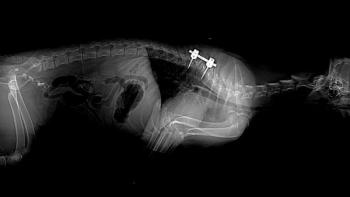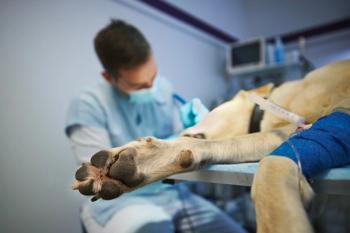
The painful dog (Proceedings)
The canine patient presented for apparent pain without an obvious cause can be a diagnostic challenge. Thorough examination is an important step in identifying a source of discomfort and determining appropriate diagnostic testing for further evaluation.
The canine patient presented for apparent pain without an obvious cause can be a diagnostic challenge. Thorough examination is an important step in identifying a source of discomfort and determining appropriate diagnostic testing for further evaluation.
Sources to consider include…
Head/Cervical Pain
* Cervical vertebral column - e.g. IVD disease, meningitis, A-A instability
o Brain disease - neoplasia, Chiari-like malformation
o Middle/inner ear canal - e.g. otitis media/interna
o Dental disease - e.g. tooth root abscess
o Esophageal disease - e.g. esophagitis
o Retropharyngeal disease - e.g. abscess
o Glandular tissue - e.g. sialoadenitis
o Temporomandibular joint - e.g. fracture/luxation
o Muscle - e.g. masticatory myositis
o Ocular disease - e.g. acute glaucoma (more likely in presence of ocular signs)
* Thoracic/Abdominal Pain
o Thoracolumbar vertebral column - e.g. IVD disease, meningitis, discospondylitis
o Retroperitoneal disease - e.g. ureteral obstruction, pyelonephritis, abscess
o Abdominal organs - e.g. pancreas, GI tract
o Aortic thromboembolism (partial)
* Caudal Body Pain
o Lumbosacral disease - e.g. IVD protrusion, stenosis
o Coxofemoral disease
o Pelvic disorders - e.g. flat bone tumors of the ilium
o Other orthopedic disease - e.g. iliopsoas, gracillis, semitendinosus muscle injury
o Prostatic disease - e.g. prostatitis
o Perineal disease - e.g. perianal fistula, anal gland abscess
* Poorly Localizable Pain - may be referred from a focal spot or more diffuse or generalized
o Meningitis ( arteritis/vasculitis)
o Polyarthritis
o Discospondylitis
o Myositis
o Hypertrophic osteodystrophy
o Tick borne diseases
o Behavioral condition?
* Therapeutic considerations
o NSAIDs – generally more effective for osteoarthritis vs. pain of neurologic origin
o Corticosteroids
o Tramadol – synthetic opioid, generally well tolerated, 1-5mg/kg in dogs, 1-2mg/kg in cats PO up to q6h; should not be used in patients taking serotonin reuptake inhibitors (e.g. fluoxetine) or monoamine oxidase inhibitors (e.g. selegiline)
o Gabapentin – works to block calcium channels at the level of the CNS, 5-25mg PO TID, dose limiting effect generally sedation
o Amantidine – oral NMDA receptor antagonist, 3-5mg/kg PO q24h; shown to improve activity level in dogs with osteoarthritis with concurrent NSAID administration
o Fentanyl dermal patch – short term solution
o Acupuncture – needles placed in specific locations induce release of neurotransmitters which act to affect sensory input, generally well tolerated
o Physical rehabilitation
Suggested reading:
Neuropathic Pain, Mathews, KA, Veterinary Clinics of North America: Small Animal Practice, Update on Pain Management, 38(6), 2008
Newsletter
From exam room tips to practice management insights, get trusted veterinary news delivered straight to your inbox—subscribe to dvm360.




